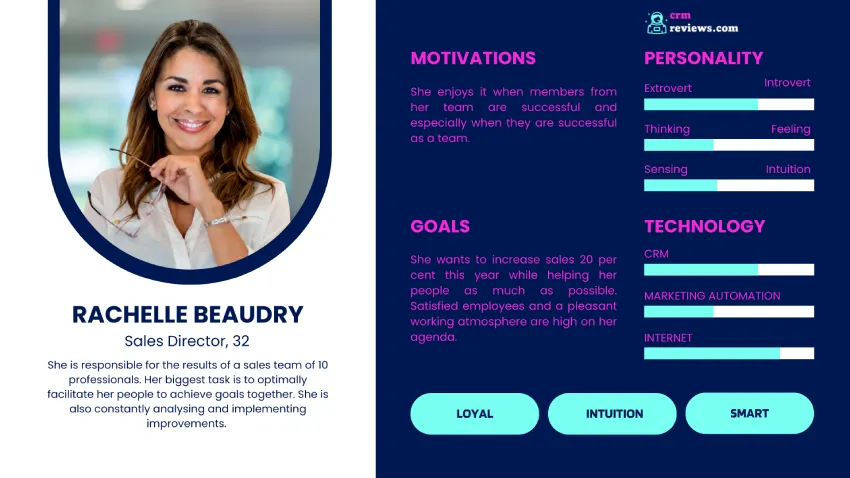A DMU is a group of people who are part of the decision-making process around certain purchases. DMU stands for Decision Making Unit and is often mentioned as a factor to consider in b2b purchasing processes. However, purchase decisions also take place in the private sphere in a DMU. A family, for example, is also a DMU within which different members influence a purchase.
Within a DMU one knows a number of types of influence areas; users, buyers, decision-makers and other people who influence the buying process. An average Business-to-business purchasing decision has 6.8 stakeholders.

We see the following roles in a DMU:
- Initiator: takes the initiative for decision-making process leading to the purchase.
- Influencer: assists in formulating the technical specifications or provides information useful in evaluating the available alternatives
- Advisor: increases number of alternatives to be considered
- Gatekeeper: contact person who controls flow of supplier information
- Decision maker: determines which supplier to contract with
- Purchaser: has formal authority to select and negotiate with a supplier
- User: the person who will use the purchased product
Tools for responding to the DMU
An example of some CRM systems that are also regularly used in the Netherlands and Belgium.
👇
There are several tools to simplify mapping and responding to the DMU. A very important one for b2b organizations is LinkedIn. This social media platform has developed into one of the largest business networking platforms in the world. LinkedIn is also developing more and more functionality to gain more insight into target groups and to get in touch with them. This includes mapping out a DMU and responding to it with content.
CRM software for a 360 view of the DMU
One way to get a better grip on the DMU and organize interactions with target groups in the right way is good CRM software. For many organizations, the CRM system forms the basis for all marketing and sales activities. Most systems provide for the capture of company data, contact person data, interaction moments such as emails, landing page visits, phone calls, or quote requests. Some packages also go further and pull information from various sources into the system to get a more complete picture of DMU members. For example, consider news articles that have been published around the company.
Business recognition software
Another type of tooling that is useful for getting a better grip on the DMU in business-to-business environments is lead identification software. These are tools that make it possible to find out which companies and in certain cases which contacts have visited the website. Not only can CRM databases be supplemented with this and interesting analyses be done, but often these tools also offer possibilities for nurturing leads.
Different buying situations within a DMU
Then we distinguish three different buying situations within DMU, referred to as a new task, modified rebuy, and straight rebuy.
- New task/New Buy: no experience with this problem. This situation happens when the organization has to purchase a certain type of product or sign a contract for a service for the first time.
- Modified rebuy: there is a modified rebuy here. An organization has previously purchased a particular product, but wants to re-buy for the next purchase.
- Straight rebuy: repeat purchase, an organization has so much experience with the particular purchase that it does not need additional information or to look at new alternatives. Thus, a company’s needs and requirements are unchanged here, and the order will be placed with the current supplier.
Source: ‘Foundations of Marketing’ Prof. Drs. B. Verhage

DMU roles change
A DMU is not a static entity. Roles of DMU members can change. For example, due to a changing composition because of a departing employee within a company. That is why many companies focus on keeping their database (such as CRM) up-to-date so that they have the right DMU members in the picture on an ongoing basis. There are also other ways to map the DMU.
How do you map out the DMU?
Personal contact
One way to map the DMU is to be in constant contact with the market (by phone, through personal sales) and in this way enrich the data in the CRM system.
Data suppliers
There are also data suppliers who can help you provide data for your DMU. Think of data suppliers like Graydon, Chamber of Commerce or Smart Profile.
Website Visitor Tracking Software
An emerging way to get a handle on a DMU is through the use of lead identification software or website visitor tracking software and tools like Online Success, SalesFeed or Leadfeeder. These tools combine data and provide direct insight into visitor profiles of website visitors. For example, by linking IP information to a database (such as the kvk database) and the website visit, direct DMU information can be provided and enriched. It is also possible to respond to the DMU in real time and contact them.
The DMU in Action: A Real-World Example
Imagine a software company deciding to upgrade its IT infrastructure by adopting a new cloud-based CRM-system. In this scenario:
- The Initiator might be the Sales Manager who identifies the need for more ways to capitalise on more sales opportunities and generate more revenue from existing customers.
- The Gatekeeper could be the CIO, who filters proposals and ensures they align with the company’s IT strategy. This person will be sensitive to information about data security, integrations with other systems and how the system interacts with the rest of the IT infrastructure.
- Influencers might include senior marketeers who provide input on the marketing-aspects of the new system. In this example, they are mainly looking for opportunities to segment audiences and apply marketing automation.
- The Decider could be the CEO or a high-ranking executive who approves the investment. This one is mainly informed by the team’s preliminary research. It is quite conceivable that he or she does want to know what kind of company they have to deal with. Status may also factor in; the brand of the tooling may be important in the decision.
- The Buyer would be the procurement department responsible for negotiating and purchasing the cloud services. The main focus is on the pricing model, any additional costs and how they relate to the available budget.
- Users would include employees who will directly interact with the new system. Users are by no means always involved in the procurement of such tools. However, it is important to do so in the best possible way. After all, users have to work with them. When they co-decide, they will pay attention to things like: user-friendliness. To convince this group, a potential CRM vendor will have to offer training or trail versions, for example.
Sales arguments focused on member in decision unit
In this table, we show which selling arguments are important for each member in the DMU. You can see that the weight of different arguments is different for each member. By responding to these in the best possible way, you provide your potential customer with the best possible information.👇
| DMU Member | Relevant Sales Arguments |
|---|---|
| Initiator (Sales Manager) | 1. Increased Sales Opportunities: Highlight how the new system can open up more avenues to capitalize on sales opportunities and generate additional revenue from existing customers. |
| 2. Enhanced Customer Engagement: Emphasize how the system can improve customer relationships and loyalty, leading to higher sales. | |
| 3. Revenue Growth: Showcase how the new system can contribute to revenue growth through improved sales processes and customer management. | |
| Gatekeeper (CIO) | 1. Data Security: Stress the system’s robust data security measures to ensure sensitive information is protected, meeting IT strategy requirements. |
| 2. System Integration: Explain how the system seamlessly integrates with existing IT infrastructure, reducing disruptions and enhancing efficiency. | |
| 3. Compatibility: Highlight how the system aligns with the company’s overarching IT strategy, emphasizing its compatibility and benefits to the existing setup. | |
| Influencers (Senior Marketers) | 1. Audience Segmentation: Showcase how the system enables precise audience segmentation for targeted marketing campaigns. |
| 2. Marketing Automation: Highlight the system’s marketing automation capabilities, which can streamline marketing efforts and improve campaign effectiveness. | |
| 3. Increased ROI: Explain how the new system can lead to a higher return on investment in marketing activities by optimizing processes and campaigns. | |
| Decider (CEO/Executive) | 1. Company Reputation: Emphasize the reputation and track record of the solution provider, instilling confidence in the company’s choice. |
| 2. Research Results: Present the results of preliminary research, demonstrating that the decision is well-informed and based on thorough analysis. | |
| 3. Status and Brand: If applicable, highlight the brand and status associated with the chosen solution, as these factors may influence the decision. | |
| Buyer (Procurement) | 1. Pricing Model: Clearly outline the pricing model of the system, demonstrating its cost-effectiveness and suitability within the budget constraints. |
| 2. Additional Costs: Provide a comprehensive breakdown of any additional costs, such as implementation or ongoing support, to ensure transparency. | |
| 3. Budget Alignment: Show how the investment aligns with the available budget and how it maximizes value for the organization. | |
| Users (Employees) | 1. User-Friendliness: Stress the user-friendliness of the system, highlighting its ease of use and reduced learning curve for employees. |
| 2. Training and Support: Offer training options and support to ensure users can effectively utilize the new system from day one. | |
| 3. Trial Versions: Provide access to trial versions or demos, allowing users to experience the system firsthand and assess its suitability. |
Responding to the DMU with Account Based Marketing
A term we see more often in Business-to-Business Marketing is Account Based Marketing. This means that a unique marketing campaign is set up on a mini-segment or a single company. One also speaks of hyper-targeting.
Within this type of campaign, a lot of attention is paid to working with the DMU. By adapting the message to the members within the DMU it is more appropriate. This makes the message more relevant and increases the chance of impact. It is therefore an efficient way of reaching target groups in the right way. This form of marketing is often applied to larger accounts or accounts with a higher order value. It can also mean a lot for accounts with a larger, more complex DMU structure.
Check out our top 3 CRM solutions for this month
Recommended Reading
Compare CRM systems
We help you compare customer relationship management software (CRM) based on several essential functions and features. Try it now
Essential CRM data for every business
But what you may not know is that your CRM data can actually be a valuable asset for your business. How do you keep your data up to date?
What is a good CRM strategy and how do you set it up?
What is a good CRM strategy and how do you set it up? Tips and a CRM strategy checklist for your organisation
Which free CRM system is the best choice in 2024?
Looking for affordable CRM systems? We will go deeper into this in this article. Read along and discover free CRM for 2024!
6 Key CRM KPI’s every business should track (with examples)
6 Key CRM KPIs every business should track. Read everything about CRM KPIs and how to be successful using them
The philosophy behind CRM software: more than just features
The philosophy behind CRM software: more than just features: use these insights from 15 years of experience with marketing, sales and CRM!
